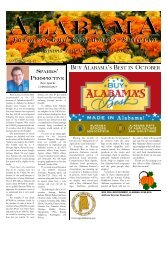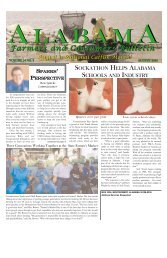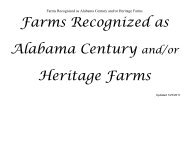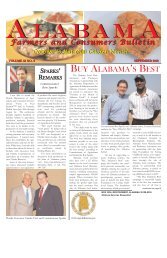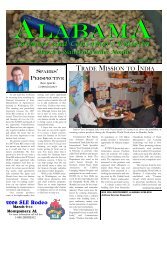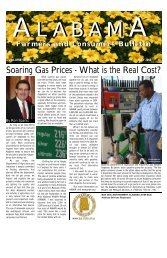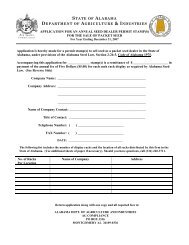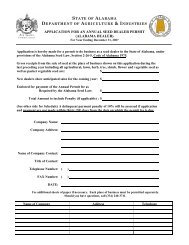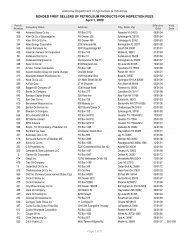Lessons Learned from Rural Schools - Alabama Department of ...
Lessons Learned from Rural Schools - Alabama Department of ...
Lessons Learned from Rural Schools - Alabama Department of ...
Create successful ePaper yourself
Turn your PDF publications into a flip-book with our unique Google optimized e-Paper software.
LLS-0010 <strong>Lessons</strong> <strong>Learned</strong>_Pub.qrk: 4/25/09 3:02 PM Page 4<br />
4<br />
Thoughts & Thanks<br />
Fromtimetotimeoverthemonthsthatwentintothisproject<br />
someone would ask how the “research” was going.<br />
While we saw ourselves doing “research,” we did not see<br />
it in quite the same light as an academic might.<br />
Instead,wewerealotlikeinvestigativereportersonthetrail<strong>of</strong><br />
a good story. We were poking into the corners <strong>of</strong> ten far-aboveaverage<br />
schools in ten rural communities trying to undercover<br />
the secrets <strong>of</strong> their success.<br />
We were diligent in our labor. What you will read in the followingpagesistheresult<strong>of</strong><br />
morethan10,000miles<strong>of</strong> travelon<br />
<strong>Alabama</strong>’s back roads, more than 300 interviews and dozens<br />
upon dozens <strong>of</strong> phone calls and hundreds <strong>of</strong> emails.<br />
WewereinPhilCampbellonabitterlycolddaywhentheskyspit<br />
snowflakes. We were in north Mobile County when a chill wind<br />
blew across a playground as dozens <strong>of</strong> students in Native American<br />
regalia danced to the steady pounding <strong>of</strong> Indian drums. We<br />
wereatPTOmeetingsandFallFestivalsandawardsprograms.<br />
We talked to mamas and daddies, to teachers, principals and<br />
superintendents. And at every turn we happened upon people<br />
who represent the heart and soul <strong>of</strong> rural <strong>Alabama</strong>.<br />
LikeBrendaCarnleywhohelpedherhusbandJimmy,thePE<br />
teacher at W. S. Harlan in Lockhart, raise $60,000 to build a<br />
new ball field and walking track. Like Dianne Romans, the city<br />
clerk <strong>of</strong> Dutton, who prepares more than 200 backpacks filled<br />
with supplies for kids at Dutton School each August. Like city<br />
councilman Webb Nall in Atmore who cooks 240 Boston butts<br />
each spring to help Huxford Elementary raise money.<br />
We did not expect to find Lake Wobegon where Garrison<br />
Keillor tells us “all the women are strong, all the men are good<br />
looking and all the children are above average.” And we didn’t.<br />
Instead, we found communities where resources are limited.<br />
Communitieswherethelastcensussaysthecollectiveaveragemedian<br />
household income was only 78 percent <strong>of</strong> the <strong>Alabama</strong> average<br />
and only 63 percent <strong>of</strong> the U.S. average. Of the ten<br />
communities,onlyonehasasmallerpercentage<strong>of</strong> familiesbelow<br />
thepovertylevelthanthestateaverage;andonlyonehasahigher<br />
percentage <strong>of</strong> high school graduates than the state average.<br />
So these are not bucolic little hamlets safe <strong>from</strong> the perils <strong>of</strong><br />
today’s society. At every school the principal told us that at least<br />
50 percent <strong>of</strong> all students come <strong>from</strong> single-parent homes.<br />
In a gym full <strong>of</strong> parents one night, the principal confided,<br />
“probably 25 percent <strong>of</strong> them have a drug issue.” On a playground<br />
one Friday afternoon a principal wished a fifth-grader a<br />
“good weekend” and then turned to the visitor and said, “He<br />
may never make it because <strong>of</strong> the home he goes to every day.”<br />
Not only are resources for the communities limited, the same<br />
is true <strong>of</strong> the schools. Of the 131 school systems in the state, figures<br />
<strong>from</strong> the <strong>Alabama</strong> <strong>Department</strong> <strong>of</strong> Education show that<br />
five<strong>of</strong> the10systemsstudiedareinthebottom25percentwhen<br />
it comes to funding <strong>from</strong> local sources.<br />
Yet in spite <strong>of</strong> the obstacles, each <strong>of</strong> the schools studied are<br />
examples <strong>of</strong> what is possible when principals have high expectations,<br />
teachers are highly motivated and communities, limited<br />
though they may be, rally to support their school when asked to<br />
do so.<br />
No, we didn’t find Lake Wobegon. Nor did we find any deep<br />
darksecrets,silverbulletsormagicpotions.Instead,wefoundalot<br />
<strong>of</strong> common sense, mixed with a lot <strong>of</strong> passion, love and caring.<br />
We found ten schools that show with certainty what our potentialisinrural<strong>Alabama</strong>.Wealsore-discoveredwhyruralcommunities<br />
are such special places.<br />
Of course, any undertaking <strong>of</strong> this magnitude requires the<br />
support <strong>of</strong> many people. Ron Sparks, Commissioner <strong>of</strong> Agriculture&Industries,wasenthusiasticaboutthisproject<strong>from</strong>the<br />
beginning and <strong>of</strong>fered his support at each step along the way.<br />
Jerry Newby, President <strong>of</strong> the <strong>Alabama</strong> Farmers Federation,<br />
championed the cause and played a key role in getting a grant<br />
<strong>from</strong> the ALFA Foundation to fund the study. Ron Scott, Executive<br />
Director <strong>of</strong> the Economic Development Association <strong>of</strong><br />
<strong>Alabama</strong>,volunteeredtohandleallthebookkeepingdutiesthat<br />
gowithtimelydisbursement<strong>of</strong> funds.Dr.JoeMorton,StateSuperintendent<br />
<strong>of</strong> Education, readily lent his support and opened<br />
doors with local education leaders.<br />
And without doubt, this project would’ve never gotten <strong>of</strong>f the<br />
ground without the unqualified support <strong>of</strong> the principals <strong>of</strong> the<br />
schools we examined. They set up meetings, looked up phone<br />
numbers,tookusontours,calledmayors,answeredourphonecalls<br />
andrespondedtoouremailswithoutfailandwithoutcomplaint.<br />
They also became our friends. And for this reason, we are<br />
grateful to Richard Bryant, Buddy Dial, Jackie Ergel, Christy<br />
Hiett, Amy Hiller, Jacqui James, John Kirby, Aimee Rainey,<br />
Donna Silcox and Brent Zessin.<br />
Gerald Carter<br />
Larry Lee<br />
Dr. Owen Sweatt<br />
The Center For <strong>Rural</strong> <strong>Alabama</strong> • (334) 240-7272



